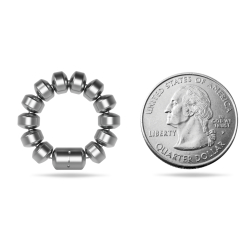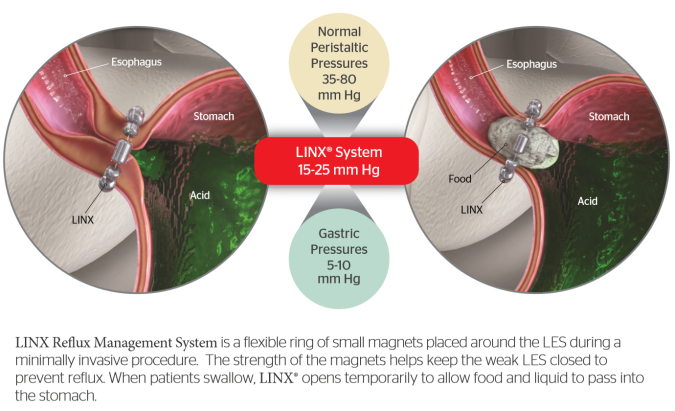Acid Reflux or GERD and the LINX Procedure
Dr. Matthew Smith explains what acid reflux or GERD is and how the LINX procedure can help.
What is acid reflux or GERD?
Acid reflux or gastroesophageal reflux (GERD) is a condition where acid, which your stomach makes to help you absorb food and is a normal process in your stomach, ends up leaving your stomach and going back up into your esophagus. It causes a burning sensation because it causes inflammation of the lining of the esophagus. Not everybody who has acid reflux needs surgery. Over time, that valve in between your stomach and your esophagus can start to weaken or not work as well. The angle can actually change because some people have part of the stomach that comes up into their chest. That's called a hiatal hernia. Not everybody who has acid reflux has a hiatal hernia, but the hiatal hernia itself isn't the problem. It's the fact that it's changed the angle of that valve so that it doesn't work as well.
How is acid reflux or GERD treated?
I do quite a bit of testing to try to make sure that's truly the problem—because there's a lot of other problems that can feel like you have heartburn that aren't necessarily acid reflux related—and to see which surgery might be best for you if that's the route you decide to go.
There's medical options. There's a PPI (proton pump inhibitors) therapy like omeprazole or pantoprazole. There's also another medication called an H2 blocker (Pepcid or famotidine) that's sometimes used. Those are great drugs. But the ultimate cure is helping that flap valve close better so that you don't have acid coming up into your esophagus anymore. And the medications just kind of mask that by decreasing the acid in your stomach. So if we recreate that flap valve with surgery, then we can have a better system that leads to more patient satisfaction. It leads to less problems down the road in my opinion because patients come off all those medications that have been shown to cause osteoporosis, C. diff, kidney problems, and even sometimes heart and brain problems in some smaller studies.
Talk about the LINX procedure.
The LINX procedure is pretty cool because it is a newer procedure. The Nissen fundoplication is kind of the tried and true. It's been around for 60 years. It's the one that everything is compared to. But the LINX, it's kind of the new kid on the block. And by that I just mean that it's been around for about 10 years. We're still finding out and still doing data on it. It's definitely a newer procedure than the Nissen that it's being compared to.
 The long-term results of LINX are pretty good. It's done laparoscopically with a tiny incision on the belly. We go in and fix the hiatal hernia. We pull all the stomach back down in the belly where it's supposed to be out of the chest. We close up the diaphragm behind it. We put in these magnetic beads around the bottom of the esophagus that open and close whenever food comes through, and that's to simulate the lower esophageal sphincter muscle or the opening and closing of that sphincter muscle, much the way your body should have been doing before.
The long-term results of LINX are pretty good. It's done laparoscopically with a tiny incision on the belly. We go in and fix the hiatal hernia. We pull all the stomach back down in the belly where it's supposed to be out of the chest. We close up the diaphragm behind it. We put in these magnetic beads around the bottom of the esophagus that open and close whenever food comes through, and that's to simulate the lower esophageal sphincter muscle or the opening and closing of that sphincter muscle, much the way your body should have been doing before.
The difference is that the Nissen you kind of have to slowly advance patients back to a soft diet over time. The LINX you actually want them eating every hour while they're awake. The LINX is an outpatient surgery so they come in day of, they get the LINX, and they go home the same day.

LINX Reflux Management System Important Safety Information
The LINX Reflux Management System is a laparoscopic, fundic-sparing anti-reflux procedure indicated for patients diagnosed with Gastroesophageal Reflux Disease (GERD) as defined by abnormal pH testing, and who are seeking an alternative to continuous acid suppression therapy (i.e. proton pump inhibitors or equivalent) in the management of their GERD. Rx Only. Contraindications: Do not implant the LINX system in patients with suspected or known allergies to titanium, stainless steel, nickel, or ferrous materials. Warnings: The LINX device is considered MR Conditional in a magnetic resonance imaging (MRI) system up to either 0.7 Tesla (0.7T) or 1.5 Tesla (1.5T), depending on the LINX model implanted. Laparoscopic placement of the LINX device is major surgery. General Precautions: The LINX device is a long-term implant for use in patients 21 years or older. Medical management of adverse reactions may include explantation and/or replacement. Potential Risks Associated with LINX System: belching, decreased appetite, device erosion, device migration (device does not appear to be at the implant site), dysphagia (difficult swallowing), flatulence, hiccups, inability to belch or vomit, infection, nausea, odynophagia (painful swallowing), pain regurgitation, stomach bloating, weight loss, and worsening of preoperative symptoms. Your physician can help you determine if LINX is right for you. Patient results may vary. For full patient information visit www.linxforlife.com or www.ethicon.com.